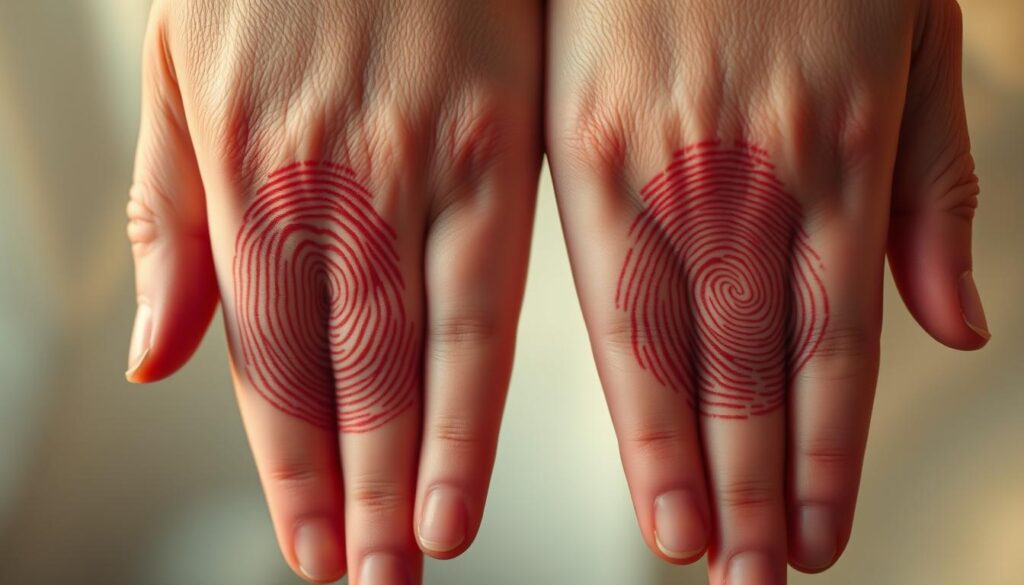Fingerprints are unique and key in forensic science. Many think twins have different fingerprints, especially identical twins fingerprints. Even though they share almost the same genes, each twin gets a unique set of fingerprints. This is due to a mix of genes and environmental factors during growth in the womb and after birth.
This article looks into the science behind the uniqueness of fingerprints. It shows how even identical twins can have their own distinct fingerprints.
Key Takeaways
- Identical twins’ fingerprints are not identical due to various factors.
- Fingerprint uniqueness is determined by both genetics and environmental influences.
- Forensic science highlights the importance of unique fingerprints in identity verification.
- Understanding the formation of fingerprints can aid in fields like criminal investigations.
- The development of fingerprints begins in the womb and continues after birth.
The Science Behind Fingerprint Formation
Fingerprint formation is a complex mix of genetics and environment. Genetics plays a big role, but so does the environment. This mix makes each person’s fingerprints unique, even among identical twins.
Genetic Factors Influencing Fingerprints
Genetics shape the patterns in our fingerprints. They influence the formation of loops, whorls, or arches. Even identical twins, sharing the same genes, have different fingerprints. This shows how genetics helps make our fingerprints unique.
Environmental Impact During Development
Environment plays a big part in fingerprint development before birth. Things like the length of the umbilical cord and where the baby is placed in the womb matter. These factors add to the differences in fingerprints, even among identical twins.
| Factor Type | Example Influence |
|---|---|
| Genetic | Predisposition to specific patterns (e.g., loops or whorls) |
| Environmental | Position in the womb affecting ridge detail |
| Nutritional | Variability in blood flow influencing thickness of ridges |
| Intrauterine Conditions | Effects of umbilical cord length on finger placement |
Understanding Identical Twins and Their DNA
Twin births come from two main ways: monozygotic and dizygotic. These differences show us a lot about our genes and who we are. They help us see what we share and what makes us different.
Monozygotic vs. Dizygotic Twins
Monozygotic twins, or identical twins, start from one egg that splits. This means they have almost the same DNA. On the other hand, dizygotic twins, or fraternal twins, come from two eggs fertilized by different sperm. They have about 50% of the same DNA, as regular siblings.
Shared and Unique Genetic Traits
Even though monozygotic twins look very alike, they can be different because of their environment and epigenetic factors. These things can change how genes work. This means they can have different traits, even if they share a lot of DNA.
Dizygotic twins can also be quite different because they have their own unique genes. This shows how complex it is to understand what makes each twin special. It’s all about the mix of shared and unique traits.
Twins Have Different Fingerprints
Identical twins have unique fingerprints, which is interesting for biometric identification. They share the same DNA but their fingerprints are different. This shows how important these differences are in forensic science.
Probability of Identical Fingerprints
It’s very rare for identical twins to have the same fingerprints. They might look similar, but their fingerprints are not likely to be the same. This shows that every person’s fingerprints are unique, even if they are twins.
Fingerprint Unique Identification Methods
Advanced tech helps tell twins’ fingerprints apart. Automated systems use special algorithms to look at the unique parts of fingerprints. This makes it possible to tell twins apart, which is key in law enforcement and security.
| Feature | MZ Twins | DZ Twins |
|---|---|---|
| Genetic Similarity | 100% | 50% |
| Fingerprint Similarity | Low Probability | Moderate Probability |
| Unique Identifiers | Many | Many |
| Identification Methods | Advanced Forensic Techniques | Standard Fingerprint Analysis |
How Fingerprints Develop in the Womb
Fingerprint formation is a fascinating process that happens in the womb. It starts between the 13th and 19th weeks of fetal development. This is when genetic instructions and environmental factors shape the unique patterns of fingerprints.
Key Stages of Fingerprint Formation
The fetus grows and changes during these weeks, affecting fingerprint patterns. The growth of fingers and skin interactions creates unique patterns. Even identical twins get different fingerprints because of this.
Contributing Environmental Factors
Things inside the womb also affect fingerprint development. Blood pressure, nutrients, and how the fetus is positioned matter. These factors make fingerprints unique, even if twins are genetically the same. It shows how nature and nurture work together in human development.
